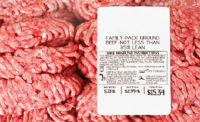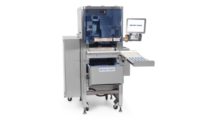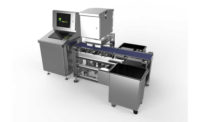Packaging Tech
The total package: Weigh-label systems
Weighing and labeling systems continue to advance in myriad areas.

Improvements to weigh-label systems include print quality and label application speed. Many systems also feature integrated inspection systems, which confirm print quality and correctness.
Today’s weigh-label systems generate better looking labels and work faster. Systems are more flexible, too. Precise weighing accuracy (to 0.02 pound) eliminates over- and underweight packs, ensuring compliance with weights and measures requirements while eliminating giveaway that erodes revenue. Many models can operate in standalone mode or be integrated with wrappers, traysealers, thermoform-fill-seal equipment and other machines and systems.
Although some units are dedicated to one label position, many systems can apply top, bottom or C labels, although some changeover or an optional module may be required. Traditional pressure-sensitive labels continue to dominate, but there have been some conversions to linerless pressure-sensitive structures, which improve sustainability by eliminating liner waste. At least one weigh-label system applies film or paper bands to carry brand and product information.
Part of the improvement in print quality and label application speed can be attributed to advances in coding technology and 300-dot-per-inch resolution. Today’s printers — typically programmable thermal-transfer, direct thermal or inkjet — can print more information faster and reproduce weight, price, sell-by date, nutrition information, country of origin and other product information as well as barcodes, QR codes and graphics. Speeds range from fewer than 100 packs per minute to up to 500 packs per minute. It’s not uncommon, however, to install a lower-speed unit and add stations as output requirements increase.
Many systems feature integrated inspection systems, which confirm print quality and correctness. Inspection typically involves a high-resolution camera, reject system and software. The camera verifies legibility and completeness and any faulty labels are rejected, eliminating downstream problems with code readability and resulting penalties or recalls.
Ease of use and quick changeover are supported by large color touch screen operator interfaces, more automated operation and easy-to-change rollstock and ink or ribbon supplies. Ethernet connectivity and advanced software and controls link equipment to up- and downstream systems and support remote diagnostics and traceability. As a result, systems can communicate with enterprise resource planning and line management systems to receive orders and transmit key metrics such as average speed, total pounds, total packs and idle time. On some systems, the operator interface can guide the operator step by step through setup and changeover. Label design and selection can be expedited by features such as onboard label formatting software and recipe storage. Stored recipes often can be accessed with just a keystroke or two.
Other common attributes include compact footprint, hygienic design and stainless steel, washdown-compatible construction. Easily removable product-contact parts simplify cleaning, minimize downtime and maximize food safety. In some cases, clean-in-place systems expedite the cleaning process and reduce downtime by minimizing the need to disassemble and reassemble the machine. When disassembly is required, it’s often tool-less to save time.
Sustainability also is a priority in today’s designs. In addition to linerless labels, which reduce waste, equipment often incorporates energy-saving modes that minimize power consumption when machines are not in use.
Weigh-label equipment is rated for specific package weights or throughput speeds. With package weight capacities ranging from about 6 to 80 kilograms and speeds from 15 packs per minute on a small tabletop model to 500 packs per minute on a fully automated unit, there’s sure to be a manual, semiautomatic or automatic weigh-label system that meets today’s and tomorrow’s needs in the back room or on the packaging line. NP
Weigh-Label System Benefits
- Deliver product information efficiently
- Enhance brand identity
- Eliminate under- and overweight packs
- Ensure compliance with weights and measures requirements
- Minimize giveaway
- Help contain costs
- Boost production efficiency
- Support product traceability needs
- Collect key metrics
- Improve inventory control
Looking for a reprint of this article?
From high-res PDFs to custom plaques, order your copy today!





